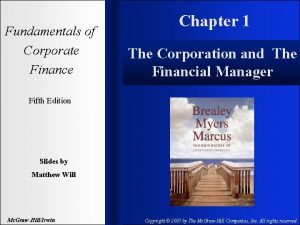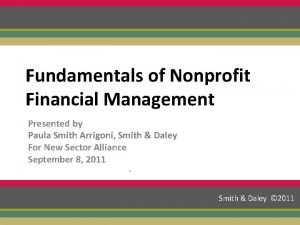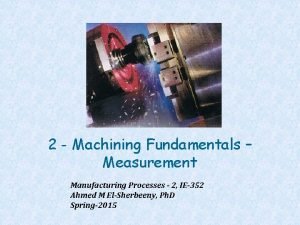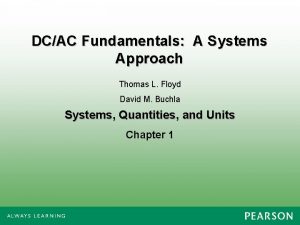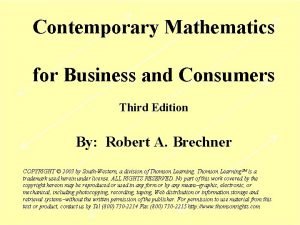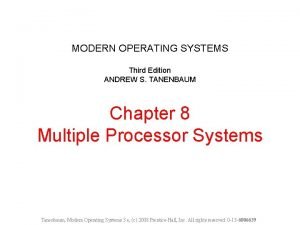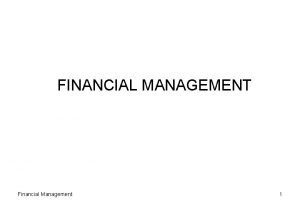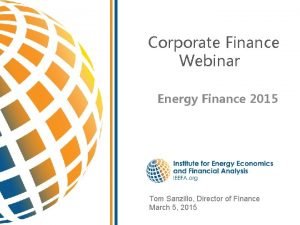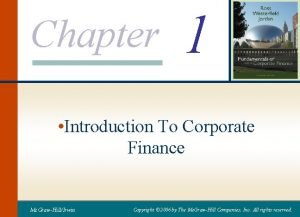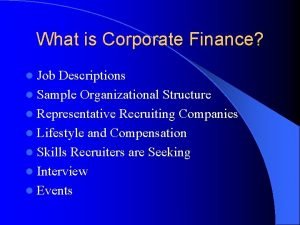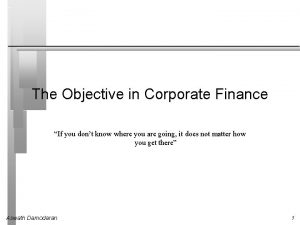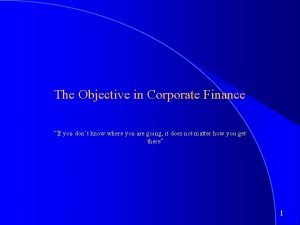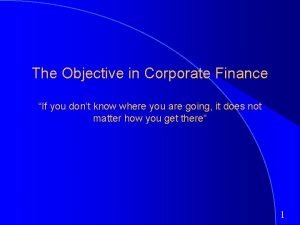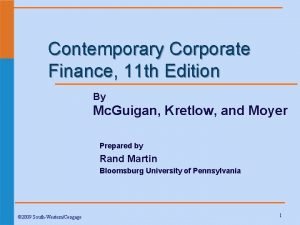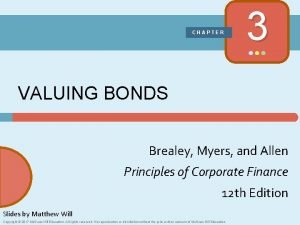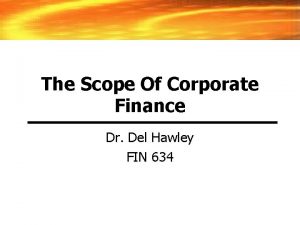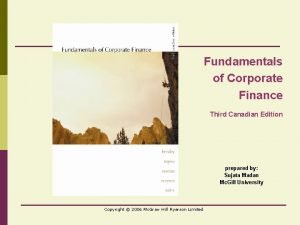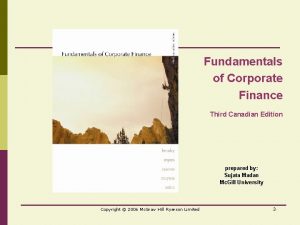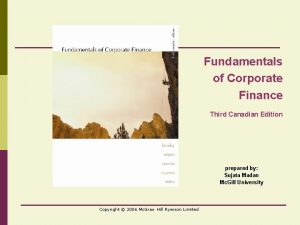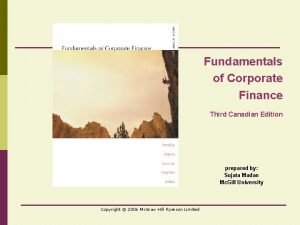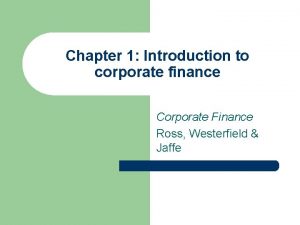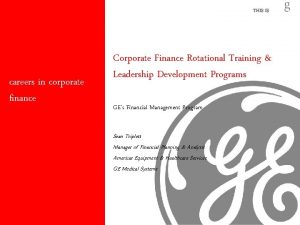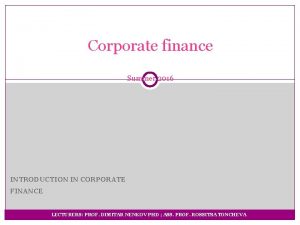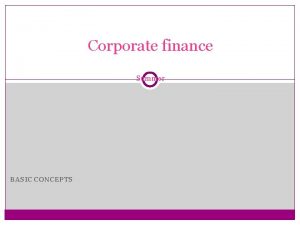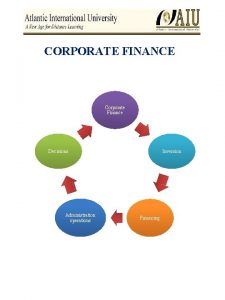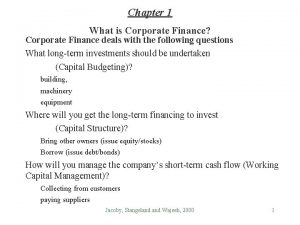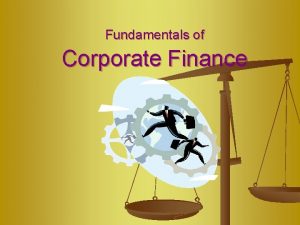Fundamentals of Corporate Finance Third Canadian Edition prepared





















































![Effective Annual Interest Rates n Definitions w Effective Annual Interest Rate [EAR]: Interest rate Effective Annual Interest Rates n Definitions w Effective Annual Interest Rate [EAR]: Interest rate](https://slidetodoc.com/presentation_image_h/9b44eaba884477eea3cfb77a06394b39/image-54.jpg)






- Slides: 60

Fundamentals of Corporate Finance Third Canadian Edition prepared by: Sujata Madan Mc. Gill University Copyright © 2006 Mc. Graw Hill Ryerson Limited 2 -

Chapter 4 The Time Value of Money n Future Values and Compound Interest n Present Values n Multiple Cash Flows n Perpetuities and Annuities n Inflation and Time Value of Money n Effective Annual Interest Rates Copyright © 2006 Mc. Graw Hill Ryerson Limited 2 -2 2

Introduction w As a financial manager you will often have to compare cash payments which occur at different dates. w To make optimal decisions, you must understand the relationship between a dollar today [Present value] and a dollar in the future [Future value]. Copyright © 2006 Mc. Graw Hill Ryerson Limited 2 -3 3

Future Value w Future value is the amount to which an investment will grow after earning interest. w Interest can be of two types: § Simple interest § Compound interest Copyright © 2006 Mc. Graw Hill Ryerson Limited 2 -4 4

Future Value n. Simple Interest w Interest is earned only on the original investment. w Example: You invest $100 in an account paying simple interest at the rate of 6% per year. How much will the account be worth in 5 years? Copyright © 2006 Mc. Graw Hill Ryerson Limited 2 -5 5

Future Value n. Simple Interest w You earn interest only on the original investment w Interest earned per year = $100 x 6% = $6. 00 w Total interest earned over 5 -year period = $6. 00 x 5 = $30. 00 w Balance in account at end of Year 5 = $100 + $30 = $130 Copyright © 2006 Mc. Graw Hill Ryerson Limited 2 -6 6

Future Value n Simple Interest Today Starting balance Year 1 Year 2 Year 3 Year 4 Year 5 $100 Interest earned Ending balance Copyright © 2006 Mc. Graw Hill Ryerson Limited 2 -7 7

Future Value n Simple Interest Today Starting balance Year 1 Year 2 Year 3 Year 4 Year 5 $100 Interest earned $6 Ending balance $106 Copyright © 2006 Mc. Graw Hill Ryerson Limited 2 -8 8

Future Value n Simple Interest Today Starting balance Interest earned Ending balance Year 1 Year 2 Year 3 Year 4 Year 5 $100 $6 $6 $6 $106 $112 $118 $124 $130 Copyright © 2006 Mc. Graw Hill Ryerson Limited 2 -9 9

Future Value n Compound Interest w Interest is earned on the interest. w Example: You invest $100 in an account paying compound interest at the rate of 6% per year. How much will the account be worth in 5 years? Copyright © 2006 Mc. Graw Hill Ryerson Limited 2 -10 10

Future Value n. Compound Interest w You earn interest on interest w Interest earned per year = Previous year’s balance x interest rate w Interest Interest w w earned earned in in in Year Year 1 2 3 4 5 = = = $100. 00 $106. 00 $112. 36 $119. 10 $126. 25 x x x Copyright © 2006 Mc. Graw Hill Ryerson Limited 6% 6% 6% = = = $6. 00 $6. 36 $6. 74 $7. 15 $7. 57 2 -11 11

Future Value n Compound Interest Today Starting balance Interest earned Ending balance Year 1 Year 2 Year 3 Year 4 Year 5 $7. 15 $7. 57 $126. 25 $133. 82 $100 $6 $106 $6. 36 $6. 74 $112. 36 $119. 10 Copyright © 2006 Mc. Graw Hill Ryerson Limited 2 -12 12

Future Value n Compound Interest w Value at the end of Year 1 = $100. 00 +[$100 x 6%] = $100 x (1+r) w Value at the end of Year 2 = $106. 00 + [$106 x 6%] = $100 x (1+r)2 ……. Value at the end of Year 5 = $100 x (1+r)5 w w Copyright © 2006 Mc. Graw Hill Ryerson Limited 2 -13 13

Future Value n Future Value w In general, value at the end of year t FV = Value today x (1+r)t Copyright © 2006 Mc. Graw Hill Ryerson Limited 2 -14 14

Future Value n Future Value w Example: You invest $100 in an account paying compound interest at the rate of 6% per year. How much will the account be worth in 5 years? FV = $100 x (1+r)t = $100 x (1+0. 06)5 = $133. 82 Copyright © 2006 Mc. Graw Hill Ryerson Limited 2 -15 15

Future Value Interest rates Copyright © 2006 Mc. Graw Hill Ryerson Limited 2 -16 16

Future Value Interest rates Note: As r increases, FV increases As t increases, FV increases Copyright © 2006 Mc. Graw Hill Ryerson Limited 2 -17 17

Future Value w Future values are higher because of the interest earned. w This leads to a basic financial principle: § A dollar received today is worth more than a dollar received tomorrow. Copyright © 2006 Mc. Graw Hill Ryerson Limited 2 -18 18

Present Value n Let’s turn things around… w How much do you need to invest today into an account paying compound interest at the rate of 6% per year, in order to receive $133. 82 at the end of five years? Copyright © 2006 Mc. Graw Hill Ryerson Limited 2 -19 19

Present Value Today Year 1 6% Year 2 6% Year 3 6% Year 4 6% Year 5 6% $133. 82 ? Present value Copyright © 2006 Mc. Graw Hill Ryerson Limited Future value 2 -20 20

Present Value Today Year 1 6% Year 2 6% Year 3 6% Year 4 6% Year 5 6% $133. 82 ? Present value = $133. 82 (1+ 0. 06)5 = $100 Copyright © 2006 Mc. Graw Hill Ryerson Limited 2 -21 21

Present Value Today Year 1 6% Year 2 6% Year 3 6% Year 4 6% Year 5 6% $133. 82 ? Present value = $133. 82 (1+ 0. 06)5 = $100 Simply invert the FV formula to get the PV formula! Copyright © 2006 Mc. Graw Hill Ryerson Limited 2 -22 22

Present Value n Present Value w In general, present value of a future cash flow: PV = FV after t periods (1+r)t Copyright © 2006 Mc. Graw Hill Ryerson Limited 2 -23 23

Present Value n Present value w Example: You have been offered $1 million five years from now. If the interest rates is expected to be 10% per year, how much is this prize worth to you in today’s dollars? Copyright © 2006 Mc. Graw Hill Ryerson Limited 2 -24 24

Present Value Today Year 1 10% Year 2 10% Year 3 10% Year 4 10% Year 5 10% $1, 000 ? Present value = $1, 000 (1+ 0. 10)5 = $620, 921 Copyright © 2006 Mc. Graw Hill Ryerson Limited 2 -25 25

Present Value vs Future Value n PV and FV are related! w The formula for PV is simply the formula for FV inverted! PV at 10% $620, 921 $1, 000 FV at 10% Copyright © 2006 Mc. Graw Hill Ryerson Limited 2 -26 26

Present Value vs Future Value n PV and FV are related! FV = PV x (1 + r)t PV = FV x 1/(1 + r)t = $620, 921 x (1 + 0. 10)5 = $1 million x 1/ (1 + 0. 10)5 = $1 million = $620, 921 Copyright © 2006 Mc. Graw Hill Ryerson Limited 2 -27 27

Multiple Cash Flows n Future Value w Example: You deposit $1, 200 in your bank account today; $1, 400 one year later; and $1, 000 two years from today. If your bank offers you an 8% interest rate on your account, how much money will you have in the account three years from today? Copyright © 2006 Mc. Graw Hill Ryerson Limited 2 -28 28

Multiple Cash Flows 0 1 8% $1, 200 2 8% 8% $1, 400 3 $1, 000 ? ? ? Copyright © 2006 Mc. Graw Hill Ryerson Limited 2 -29 29

Multiple Cash Flows 0 1 2 8% $1, 200 8% 8% $1, 400 3 $1, 000 x(1+0. 08)1=$1, 080. 00 $1, 400 x(1+0. 08)2=$1, 632. 96 $1, 200 x(1+0. 08)3=$1, 511. 65 FV = $4, 224. 61 Copyright © 2006 Mc. Graw Hill Ryerson Limited 2 -30 30

Multiple Cash Flows n Present Value w Example: Your auto dealer gives you the choice to pay $15, 500 cash now, or make three payments: $8, 000 now and $4, 000 at the end of the following two years. If your cost of money is 8%, which do you prefer? Copyright © 2006 Mc. Graw Hill Ryerson Limited 2 -31 31

Multiple Cash Flows n Problem definition w Option 1: $15, 500 today w Option 2: $8, 000 today; $4, 000 at the end of one year; and $4, 000 at the end of two years Cash flows can be compared only at the same point in time. Thus, we need to find the PV of Option 2. Copyright © 2006 Mc. Graw Hill Ryerson Limited 2 -32 32

Multiple Cash Flows n Present value of Option 2 0 1 8% 8% $8, 000 2 $4, 000 ? ? ? Copyright © 2006 Mc. Graw Hill Ryerson Limited 2 -33 33

Multiple Cash Flows n Present value of Option 2 0 1 8% 8% $8, 000 2 $4, 000/(1+0. 08)1=$3, 703. 7 0 $4, 000/(1+0. 08)2=$3, 429. 3 6 PV = $15, 133. 06 Copyright © 2006 Mc. Graw Hill Ryerson Limited 2 -34 34

Multiple Cash Flows n Compare the two options at the same point in time w PV of Option 1: $15, 500. 00 w PV of Option 2: $15, 133. 06 Option 1 is better for the buyer. Option 2 is better for the auto dealer. Copyright © 2006 Mc. Graw Hill Ryerson Limited 2 -35 35

Perpetuities and Annuities n Definitions w Annuity: Equally spaced and a level stream of cash flows [for a finite number of periods] w Perpetuity: Stream of level cash payments that never ends [for an infinite number of periods] Copyright © 2006 Mc. Graw Hill Ryerson Limited 2 -36 36

Perpetuities and Annuities n Perpetuities w The PV of a perpetuity is calculated by dividing the level cash flow by the interest rate 0 1 r% PV 2 r% C PV of a perpetuity = 3 r% C ……. r% C ∞ r% C C C r Copyright © 2006 Mc. Graw Hill Ryerson Limited 2 -37 37

Perpetuities and Annuities n Perpetuities w The PV of a perpetuity is calculated by dividing the level cash flow by the interest rate 0 1 r% PV 2 r% C PV of a perpetuity = r% C C r 3 ……. r% C ∞ r% C C Note: This formula gives you the present value of a perpetuity starting one period from now Copyright © 2006 Mc. Graw Hill Ryerson Limited 2 -38 38

Perpetuities and Annuities n Perpetuities w Example: In order to create an endowment, which pays $100, 000 per year, forever, how much money must be set aside today if the rate of interest is 10%? Copyright © 2006 Mc. Graw Hill Ryerson Limited 2 -39 39

Perpetuities and Annuities n Perpetuities 0 1 10% PV 2 10% $100, 000 PV of perpetuity = … …. ……. …. . $100, 000 0. 10 ∞ 10% $100, 000 = $1, 000 Copyright © 2006 Mc. Graw Hill Ryerson Limited 2 -40 40

Perpetuities and Annuities n Perpetuities w Example contd. : If the first perpetuity payment will not be received until four years from today, how much money needs to be set aside today? Copyright © 2006 Mc. Graw Hill Ryerson Limited 2 -41 41

Perpetuities and Annuities n Perpetuities 0 1 2 4 … 10% 5 PV at end of Year 3 = …. $100, 000 0. 10 $1, 000 (1. 10)3 ∞ 10% $100, 000 PV PV today = 3 $100, 000 = $1, 000 = $751, 315 Copyright © 2006 Mc. Graw Hill Ryerson Limited 2 -42 42

Perpetuities and Annuities n Annuities w The PV of a t-period annuity is given by: 0 1 r% PV 2 r% C 3 r% C ……. r% C t r% C C PV of t-period annuity = Copyright © 2006 Mc. Graw Hill Ryerson Limited 2 -43 43

Perpetuities and Annuities n Annuities w The PV of a t-period annuity is given by: 0 1 r% PV 2 r% C 3 r% C ……. r% C t r% C C PV of t-period annuity = Note: This formula gives you the present value of an annuity starting one period from now Copyright © 2006 Mc. Graw Hill Ryerson Limited 2 -44 44

Perpetuities and Annuities n Annuities w The PV of a t-period annuity is given by: PV of t-period annuity = Note: The term in the square brackets is called the present value annuity factor or PVAF. Copyright © 2006 Mc. Graw Hill Ryerson Limited 2 -45 45

Perpetuities and Annuities n Annuities w The PV of a t-period annuity is given by: PV of t-period annuity = Note: The term in the square brackets is called the present value annuity factor or PVAF can also be computed by using the annuity tables at the end of the book [Appendix A. 3]. Copyright © 2006 Mc. Graw Hill Ryerson Limited 2 -46 46

Perpetuities and Annuities n Annuities w Example: You are purchasing a car. You are scheduled to make 3 annual installments of $4, 000 per year, with the first payment one year from now. Given a rate of interest of 10%, what is the price you are paying for the car? Copyright © 2006 Mc. Graw Hill Ryerson Limited 2 -47 47

Perpetuities and Annuities 0 1 10% 2 10% $4, 000 3 $4, 000 PV of 3 -period annuity = Copyright © 2006 Mc. Graw Hill Ryerson Limited 2 -48 48

Perpetuities and Annuities n Growing Perpetuities 0 1 r% PV 2 r% C PV of a perpetuity = 3 r% C(1+g) ……. r% C(1+g)2 ∞ r% C(1+g)3 C r-g Copyright © 2006 Mc. Graw Hill Ryerson Limited 2 -49 49

Perpetuities and Annuities n Growing Annuities 0 1 r% PV 2 r% C 3 r% C(1+g) ……. r% C(1+g)2 Copyright © 2006 Mc. Graw Hill Ryerson Limited t r% C(1+g)3 2 -50 50

Inflation n Definitions w Inflation: Rate at which prices as a whole are increasing. w Nominal interest rate: Rate at which money invested grows. w Real interest rate: Rate at which the purchasing power of an investment increases. Copyright © 2006 Mc. Graw Hill Ryerson Limited 2 -51 51

Inflation n Formulae w The exact formula: 1+ real interest rate = 1+ nominal interest rate 1 + inflation rate w The approximation: Real interest rate ≈ nominal interest rate – inflation rate Copyright © 2006 Mc. Graw Hill Ryerson Limited 2 -52 52

Inflation w Example: If the interest rate on one year government bonds is 5. 0% and the inflation rate is 2. 2%, what is the real interest rate? Real interest rate = [(1+ 0. 05)/(1+0. 022)]-1 = 1. 027 -1 = 2. 7% Real interest rate ≈ 5% - 2. 2% = 2. 8% Copyright © 2006 Mc. Graw Hill Ryerson Limited 2 -53 53
![Effective Annual Interest Rates n Definitions w Effective Annual Interest Rate EAR Interest rate Effective Annual Interest Rates n Definitions w Effective Annual Interest Rate [EAR]: Interest rate](https://slidetodoc.com/presentation_image_h/9b44eaba884477eea3cfb77a06394b39/image-54.jpg)
Effective Annual Interest Rates n Definitions w Effective Annual Interest Rate [EAR]: Interest rate that is annualized using compound interest w Annual Percentage Rate [APR]: Interest rate that is annualized using simple interest Copyright © 2006 Mc. Graw Hill Ryerson Limited 2 -54 54

Effective Annual Interest Rates n Formulae where m = number of compounding periods in year Copyright © 2006 Mc. Graw Hill Ryerson Limited 2 -55 55

Effective Annual Interest Rates w Example: Given a monthly rate of 1%, what is the Effective Annual Rate [EAR]? What is the Annual Percentage Rate [APR]? Copyright © 2006 Mc. Graw Hill Ryerson Limited 2 -56 56

Effective Annual Interest Rates w Example: Given a monthly rate of 1%, what is the Effective Annual Rate [EAR]? What is the Annual Percentage Rate [APR]? APR = 1% × 12 = 12% Copyright © 2006 Mc. Graw Hill Ryerson Limited 2 -57 57

Summary of Chapter 4 w Future value (FV) is the amount to which an investment will grow after earning interest. w The present value (PV) of a future cash payment is the amount you would need to invest today to create that future cash payment. Copyright © 2006 Mc. Graw Hill Ryerson Limited 2 -58 58

Summary of Chapter 4 w A level stream of payments which continues forever is called a perpetuity. w One which continues for a limited number of years is called an annuity. w You can use the FV and PV formulas to calculate their value or you can use the shortcut formulae. Copyright © 2006 Mc. Graw Hill Ryerson Limited 2 -59 59

Summary of Chapter 4 w Annual percentage rates (APR) do not recognize the effect of compound interest, that is, they annualize assuming simple interest. w Effective Annual Rates (EAR) annualize using compound interest. Copyright © 2006 Mc. Graw Hill Ryerson Limited 2 -60 60
 Fundamentals of corporate finance third canadian edition
Fundamentals of corporate finance third canadian edition Sujata madan
Sujata madan Fundamentals of corporate finance fifth edition
Fundamentals of corporate finance fifth edition Fundamentals of corporate finance 6th edition
Fundamentals of corporate finance 6th edition Fundamentals of corporate finance chapter 6 solutions
Fundamentals of corporate finance chapter 6 solutions Fundamentals of corporate finance chapter 1
Fundamentals of corporate finance chapter 1 Fundamentals of corporate finance, chapter 1
Fundamentals of corporate finance, chapter 1 Objectives of corporate finance
Objectives of corporate finance Corporate finance tenth edition
Corporate finance tenth edition Corporate finance tenth edition
Corporate finance tenth edition Corporate finance tenth edition
Corporate finance tenth edition Corporate finance tenth edition
Corporate finance tenth edition Corporate finance tenth edition
Corporate finance tenth edition Marketing an introduction 6th canadian edition
Marketing an introduction 6th canadian edition Accounting principles second canadian edition
Accounting principles second canadian edition Accounting principles second canadian edition
Accounting principles second canadian edition Accounting principles second canadian edition
Accounting principles second canadian edition Accounting principles second canadian edition
Accounting principles second canadian edition Gj mount classification of dental caries
Gj mount classification of dental caries Gingival third vs cervical third
Gingival third vs cervical third Finance fundamentals for nonprofits
Finance fundamentals for nonprofits Real estate finance fundamentals
Real estate finance fundamentals Fundamentals of information systems 9th edition
Fundamentals of information systems 9th edition Fundamentals of information systems 9th edition
Fundamentals of information systems 9th edition Fluid mechanics fundamentals and applications 3rd edition
Fluid mechanics fundamentals and applications 3rd edition Thomas l floyd digital fundamentals 10th edition
Thomas l floyd digital fundamentals 10th edition Machining fundamentals 10th edition
Machining fundamentals 10th edition Fundamentals of organizational communication 9th edition
Fundamentals of organizational communication 9th edition Fundamentals of organizational communication 9th edition
Fundamentals of organizational communication 9th edition Digital fundamentals by floyd 10th edition
Digital fundamentals by floyd 10th edition Digital fundamentals by floyd
Digital fundamentals by floyd Dc/ac fundamentals 1st edition
Dc/ac fundamentals 1st edition Computer security fundamentals 4th edition
Computer security fundamentals 4th edition Management fundamentals 8th edition
Management fundamentals 8th edition Fundamentals of information systems 9th edition
Fundamentals of information systems 9th edition Fundamentals of abnormal psychology ninth edition
Fundamentals of abnormal psychology ninth edition Fundamentals of information systems 9th edition
Fundamentals of information systems 9th edition Thermal conduction resistance
Thermal conduction resistance The fundamentals of political science research 2nd edition
The fundamentals of political science research 2nd edition Principles of economics third edition
Principles of economics third edition Organic chemistry david klein 3rd edition
Organic chemistry david klein 3rd edition Organic chemistry third edition david klein
Organic chemistry third edition david klein Business mathematics third edition
Business mathematics third edition Modern operating systems tanenbaum
Modern operating systems tanenbaum Lifespan development third edition
Lifespan development third edition Lifespan development third edition
Lifespan development third edition Essential cell biology chapter 1
Essential cell biology chapter 1 Graphical display
Graphical display Financial theory of investment
Financial theory of investment Tom sanzillo
Tom sanzillo Investment banking activities
Investment banking activities Introduction to corporate finance what companies do
Introduction to corporate finance what companies do Corporate finance job scope
Corporate finance job scope Objective of corporate finance
Objective of corporate finance Objectives of corporate finance
Objectives of corporate finance Objective of corporate finance
Objective of corporate finance Maastricht university ib
Maastricht university ib Contemporary corporate finance
Contemporary corporate finance Principles of corporate finance chapter 3 solutions
Principles of corporate finance chapter 3 solutions Scope of corporate finance
Scope of corporate finance Objectives of corporate finance
Objectives of corporate finance






